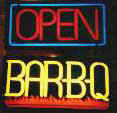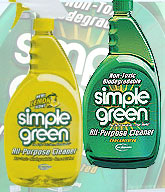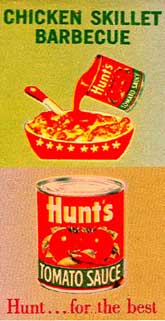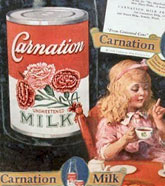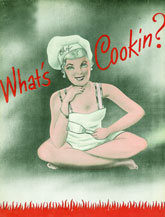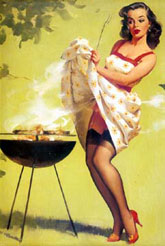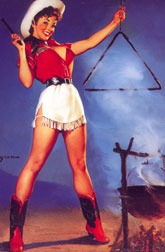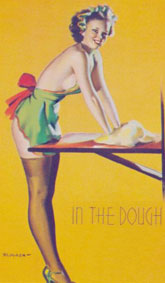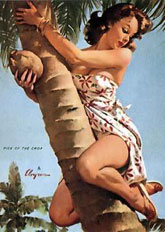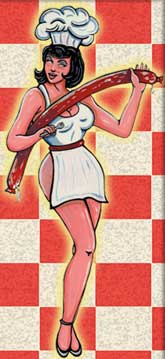Contact BBQbyDan
www.BBQDan.com
Search
KCBS BBQ Cook-Off Info
Recipes, Smoking Meats
Recipes, Grilling
|
|
||
|
BBQbyDan
BRISKET SMOKING BASICS
PACKAGING, TYPES, AND PARTS OF A BRISKET The words used in the world of brisket are:
-
Point, Tip, and Deckle, the thicker more point like end. I like
this the best for flavor and fat content
-
Flat and Blade, this is typically the thinner, wider section. I
like this the least as it contains less fat
and can be dryer. These two distinct pieces of the brisket come attached as one piece of meat, or a whole brisket, via a fat layer. But have grains that run the opposite direction and have different textures and fat content. So, you will have to taste test what you like best and how you will choose to cook the brisket, either whole or separated.
Your typical brisket that you will find in a store come in various cuts, packages, and types.
- At Costco for example you will always find the Flat or Blade, well trimmed of fat (separated from the tip or point. I DO NOT LIKE THAT. The cryopac packer package (what all meats come in from a slaughter house) has been opened, the brisket separated, and the flat trimmed for you at an extra cost to you of course. I typically pass on those. Might cost up to $4.99 per pound versus $1.39 for a whole..
- At Smart & Final, most supermarkets, and other stores, you will find the brisket typically comes in a cryopac package, a packer cut, and mostly by the packing plant of IBP in either a Choice or Select cut. This means that the Packing plant cuts its meat in a standard way and puts it in a vacuum sealed, heavy plastic, bag that beef can live in for 2 - 4 weeks under correct refrigeration. I really like my briskets, and all meat products for that matter, to come like this. Reference to Choice or Select that is the grading and the amount of fat that is marbled throughout the meat. More fat is good and a higher grade. Remember this, PCS (as in portable telephones), convert it to (P)rime, (C)hoice, (S)elect. Prime is BEST, and Select is least BEST. Nice little memory tool.
When meat comes packaged in a cryopac package with a packer cut you get it the cheapest in that the butcher does not have to spend his time re-trimming it to political correctness. Now you are charged less and get to trim it the way you want as well as have all the fat on it you might want.
So, needless to say. I always buy and cook a full, uncut, brisket and recommend that. The downside is it will take me 11-14 hours versus half that if I did separate the brisket. So, choose which method pleases you. But, be warned each piece will cook differently separated than it will if attached.
You might also look for a brisket with white fat versus a yellow fat. This most likely indicates it is pure corn fed and fresher. This is a good thing, like Martha says. Also, you might hold it by the two ends and see if one is more flexible than another. This might indicate the meat is more tender then not. And, the last thing is some folks say that cows, 90% of the time, typically lay on their right sides when resting. So, you might want to try for a left-sided brisket. All these hints or tips might help or not. I have seen what would be described above turn out to be the best and visa versa.
TRIMMING AND PREPARATION I trim most of the fat off the brisket. I leave about 1/8 - 1/4. I don't go into the crevices (between point and flat) very deeply at all. I will try and get most of the membrane type fat off where possible to allow for a better tasting texture, rendering, and seasoning (rub, marinade, glaze) penetration and build-up). This is not a point to get to anal about. Just leave a bit of fat on to self-baste, but not enough to bother you while slicing and eating. After it is cooked it all tastes crusty and great! You might take a LOT of fat off your brisket. Maybe 1/4 of its entire weight. Oh well. That is the way they come.
This process can take a bit of time and a lot of fat will come off, but it is worth it.
COOKING IN A SMOKER. I always cook a whole packer cut brisket if possible. I typically don't want to work, or stay up all night, watching a fire. So, I usually don't put my butts or briskets in a big log-burning or off-set type cooker. I will start with a Weber Smoky Mountain (WSM) which can go unattended for up to 7 - 8 hours if packed with water and fuel. I put a whole packer cut on a rack in a WSM with no problem with mesquite fuel and a chunk of oak and hickory, maybe, if they are handy. I have put as big as a 16 pound. I just squeeze it together (ball like) when putting it on the rack. After 6 - 8 hours it is not an issue anymore as it has reduced in size substantially. Usually at that time I will rotate, maybe put in the oven if at home (heck, the smoking process is now over, why waste valuable smoking woods and time), of move it to a big smoking pit, depending upon where I am and what I am doing. I cook my briskets between 245 - 250 for 12 - 15 hours for a 11-14+ pounder. I will start basting about 2/3rds through the process and about every 90 minutes from that point on.
For a brisket, since it has so much meat that will never get the direct contact of the smoke, I will use pecan or mesquite and a dab of hickory, maybe oak. But, mostly mesquite. This is due to the fact that here in Southern California mesquite is the cheapest and easiest to come by. oak and hickory are hard to find and expensive. I prefer however the taste of oak and hickory to mesquite, but so little of the edible stuff get the direct contact it still is QUITE FINE either way. Now, Ribs or Chicken, I will not cook in mesquite due to the fact that most of what you eat has had a lot of hours of mesquite touching it directly. So, that is just my personal taste and preference.
THE BRISKET COOKING PROCESS As I said before I cook my briskets between 245 - 250 for 15 hours for a 11-14+ pounder and will rotate and turn then start basting about half-way through the cooking process. I would turn and marinade at hourly to 90 minute intervals (if you don't wrap), adds lots of layered flavors to Mr. Bark, after the brisket has been on at least 8 hours or so. Due to the hourly marinade (heat loss each entry) it will take the full 15 hours to cook.
If you like Mr. Brown, or a crispy crust, don't wrap. If you like soft crust, then wrap. I have done an many wrapped as not and normally don't wrap for myself or a contest but wrapping is fine as well if you like it that way. I really like the BBQ crispiness and taste come with a non-wrapped brisket versus the more steamed like taste that comes with wrapping. Each to his own.
Once you reach a point where you think it might be done there are several ways of testing. You can to the fork test in the thicker part of the flat, which works sometimes, and sometimes does not. If it is going to work you will be able to feel an easy entry into the thick side of the flat and it won't lift when removing. However, I have seen the opposite as well on very well cooked briskets. I would pull between 193 and 199 measured right where the flat joins the point. On rare occasions I have seen briskets cook for up to 16 hours and never rise above 185, fail the fork test, yet be the best, tender, pull-apart, and moist piece of meat.
FINISHING AND GLAZING So, if you are going to glaze I would remove it just when you find it is done to your liking. Put your favorite glaze on, and then put it back it back in for 30 minutes. This will caramelize or glaze a bit and make it taste better. Typically sweet does not go with brisket like it does pork. But, hey, do what makes you feel good.
If it get done early I will wrap in film (cellophane) or foil, some towels or blankets, and then put in a cooler. Or not wrap and put in a catering heat-holding box (Cambro like) and let it continue to cook a bit. It can hold its heat for many hours and get better yet. Might lose a bit of Mr. Brown however.
So, the bottom line is sometimes it is a tough thing to judge exactly. I just find that cooking my brisket for 10-15 hours, basting often after 2/3rds cooking time, and starting to check for doneness at about 11 hours gets me success most of the time.
When I do them this way the moisture pours out of them like a fire-hose, they break apart perfectly, and they taste great with a bit of BBQbyDan Fancy Glaze
TRIMMING AND SLICING When you lay your brisket out to trim or slice for the first time simply push your finger into the middle the brisket a slight distance. You will immediately detect which way the grain is going. Then cut it opposite of that. I then typically separate the flat from the point because their grains do run different directions and this gives me a chance to remove the fat in between. Then go for what pleases you. For me it is the marbled, moister, point, or deckle. Often I will just slice coarsely, shred, and chop.
Dan Cannon .
|
||
|
||
|

